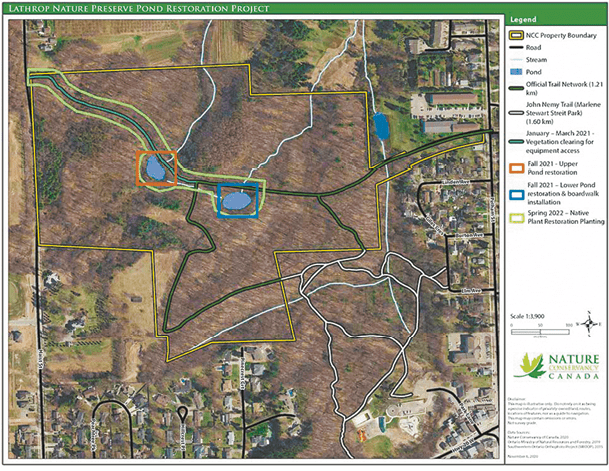Nature Conservancy of Canada wants to eliminate risk for those using the trails and damage to Twelve Mile Creek downstream
Work will soon begin to make improvements to the Lathrop Preserve trail system and the headwaters of Twelve Mile Creek which lie within its boundaries. The planned major reconstruction in the wooded preserve is the result of surveys done by the Nature Conservancy of Canada (NCC), which owns the tract, and Niagara College students in the post-graduate Ecosystem Restoration and GIS Programs.
Their studies revealed that the old railway berm which supports the main trail is rapidly failing and could become a hazard to hikers. The berm holds back groundwater in two ponds along the south side of the embankment that is seeping through the berm, weakening it. This seepage, warmed by the sun as it strikes the two ponds, becomes a small stream that is a tributary of Twelve Mile Creek. The warm water is damaging to aquatic habitat that lives in the watershed.
To counter both the gradual deterioration of the berm and the damage to Twelve Mile Creek, the Nature Conservancy has retained an environmental consulting firm, Savanta, to design and complete necessary reconstruction. Their solution calls for diverting groundwater from the upper of the two ponds to reduce the pressure on the railway embankment. The lower pond will see its level of water much reduced as well, and the berm at that point modified to include a pedestrian boardwalk. This will have the effect of lowering pressure on the berm while reducing the surface area of the ponds that is subject to solar heating.

If the NCC can get the necessary permits for the work from the MNRF, the Niagara Escarpment Commission, the Niagara Peninsula Conservation Authority, and the Town of Pelham, as well as raise the necessary funds to complete the work, reconstruction can begin as early as this winter. A trail to support heavy equipment will be built from Haist Street into the ponds, causing the removal of approximately 25 mature trees. The NCC points out that the trees will be left on site to provide habitat for wildlife and that the trail will be erased and rehabilitated when the work is complete.
Liv Monck-Whipp is the Co-ordinator of Conservation Biology with the Nature Conservancy. She is aware of the unique and fragile nature of the land they intend to work on.
"Lathrop Nature Preserve is a very ecologically significant area,” said Monck-Whipp. “It supports many species at risk, including Butternut, American Chestnut, and Wood Thrush. Some of the headwaters of Twelve Mile Creek originate right in the middle of the Preserve. Part of NCC's stewardship includes ensuring safe hiking access and protecting this sensitive habitat.”
Prof. Ian Smith, a stream restoration expert and professor of Environmental Studies at Niagara College, extolled the value of the Preserve.
“The Lathrop Property represents not only a critical part of our Town’s rich natural heritage, but one of the last natural areas that supports Niagara Region’s only sustainable cold water stream with the remnants of the Peninsula’s last native trout population. The Nature Conservancy of Canada and its supporters have stepped up and are working to protect this irreplaceable part of Fonthill, Pelham and Niagara.”
The Lathrop Nature Preserve was donated to the Nature Conservancy in 1998 by Dr. D. Whiting and Margaret Lathrop, to preserve a significant natural setting in the core of Fonthill. It extends from Haist St. to the edge of properties facing Pelham St. and adjoins Marlene Stewart Streit Park just off Highway 20 to the south. The railway berm that bisects it was part of a rail network from more than a century ago that served the canneries and other businesses in Pelham, and the ponds adjacent to it were originally quarries for ballast to construct and maintain the rail lines. The quarries filled with ground water and culverts were inserted in the berm to drain the excess water. Those culverts plugged and collapsed long ago, causing the seepage that is gradually destroying the railway embankment.
The Niagara Chapter of Trout Unlimited Canada has been involved from the start of the restoration process, as Twelve Mile Creek has been the focus of their activity since their inception some nine years ago. Liv Monck-Whipp said the partnership with the Niagara Chapter has been key to ensuring the project enhances the creek that they are devoted to.
"We're very excited about partnering with Niagara College and Trout Unlimited Canada's Niagara Chapter. Together, they have conducted extensive restoration work within the Twelve Mile Creek watershed. This project will contribute to that bigger picture effort to improve water quality and fish habitat in Niagara's last coldwater creek."
The Niagara College students completed their studies of the property in 2019 and recommended dewatering the ponds and grading the berm to create a wetland ecosystem, similar to the Savanta plan that is being realized now. They also pointed out that encroaching development to the south and west of the property could have significant effects. They recommended careful monitoring of storm water outflow from this rapidly developing area to assess potential further damage to the berm.
Several branches of the headwaters of the Twelve originate right in urban Fonthill—one in Marlene Stewart Streit Park (which is joined by the outflow from the Lathrop Property) and another flows under Highway 20 from the Storm Water Management Pond at Rice Road. The westerly branch is protected by the park and by the Lathrop Preserve. The easterly branch, running from the storm water pond between the Lion’s Club and Pelham Cares is the subject of real concern. A recent motion put forward by Mayor Marvin Junkin asks for an independent study to determine the cause of extreme outflows during storms.


